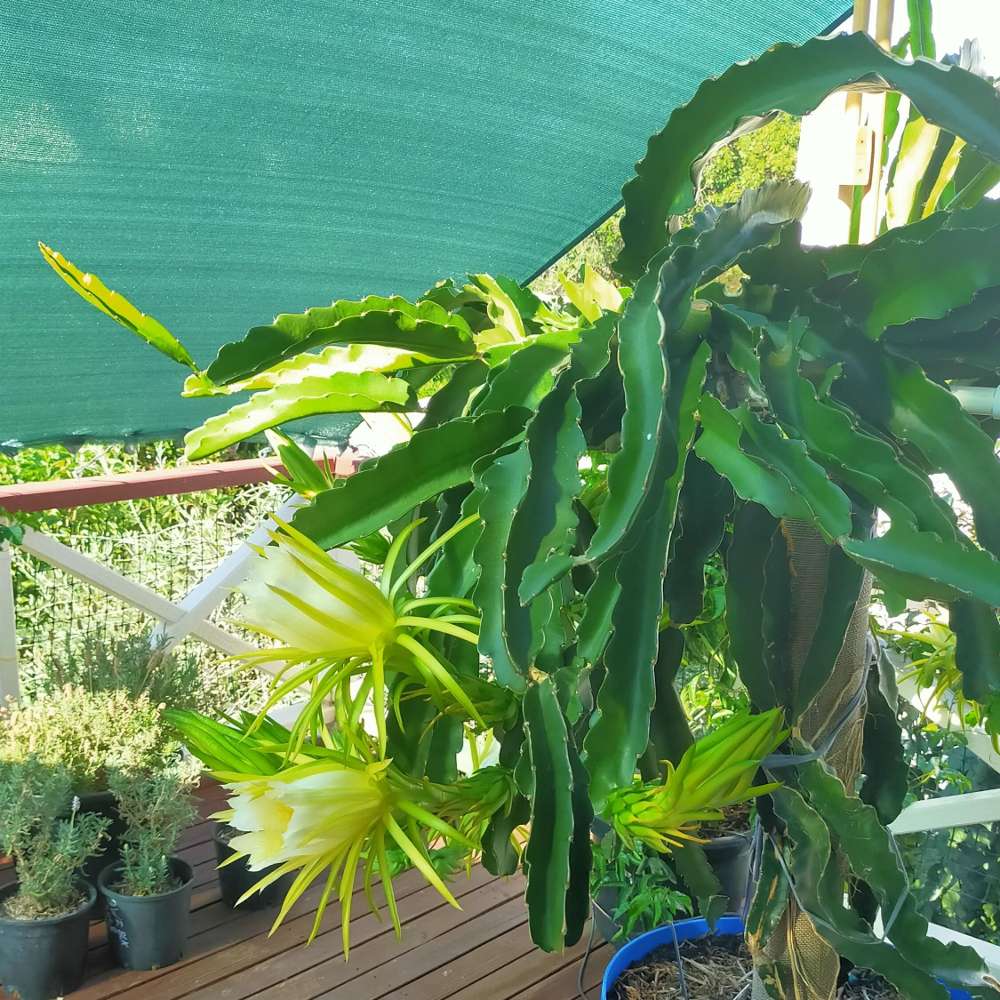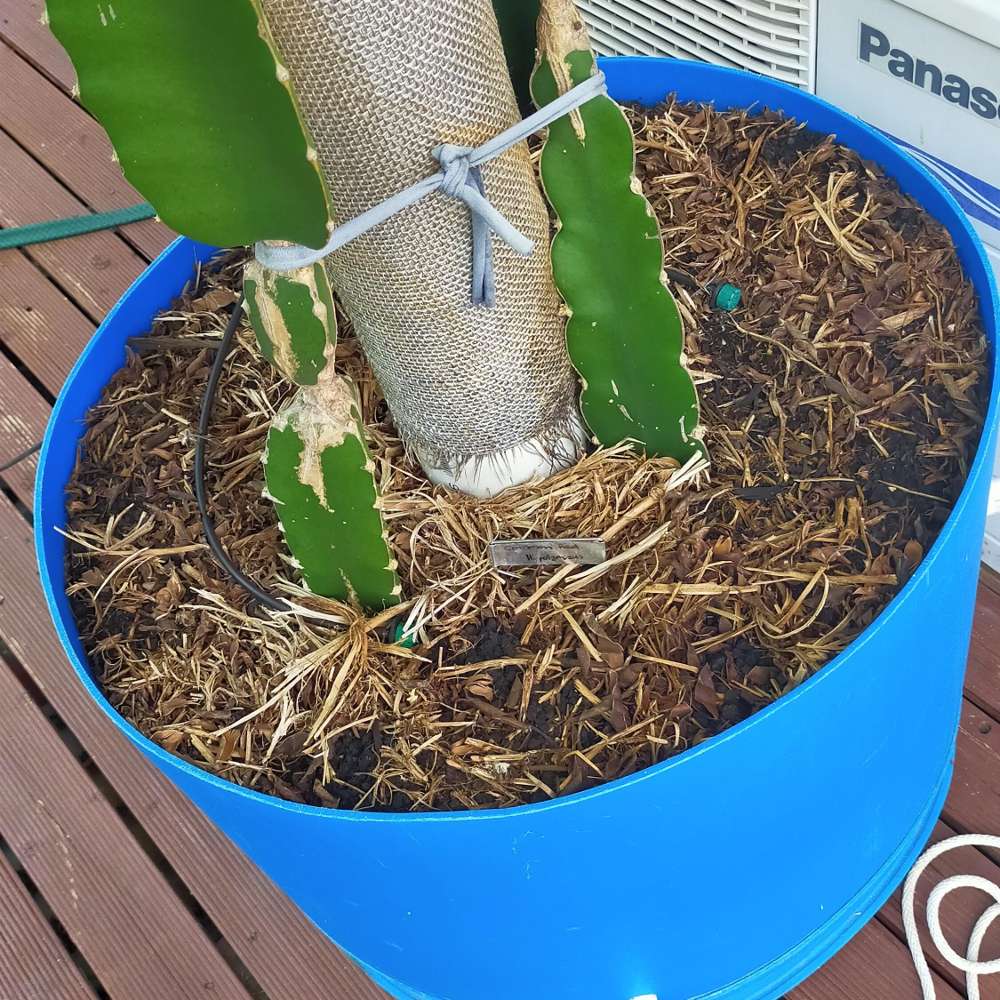Basic Care
This page covers the basics in growing dragon fruit: position and shading, soil, watering, fertilising, and mulching. For other aspects of growing dragon fruit, such as propagation, trellising, and pollination, see the drop-down menu above.
Position and Shading

Dragon fruit plants are a tropical cactus, so prefer a full-sun environment until the peak of summer, when some shading may be required. This will allow your plants to put on maximum biomass for the fruiting season, and ultimately extend the fruiting season both ways, as well as ensuring they remain healthy over the off season. However, if your climate gets very hot like where I live (up to 40+ degrees Celsius), some of the branches may turn yellow in extreme heat, which can lead to mush-like burns of rotting flesh which really hamper production. If this happens, cut away the rotting flesh immediately before it spreads and clean with a paper towel (see how to do this) to stop the plant from wasting energy on trying to heal itself. Dragon fruit branches can also shrivel badly in extreme heat, usually due to not enough water and/or lack of bud thinning. For varieties with larger fruit, I like to stick to the old saying, “Three is a crowd,” and keep a maximum of two buds per branch. Otherwise, the branch simply won’t have enough nutrients to support all its fruit, and you will end up with lots of small, sour fruits and a terribly malnourished branch that may need removing if it doesn't recover by the following season.
Of course, some varieties are more sensitive than others. In my experience, Yellow Colombiana and Colombian Supreme suffer the most from sun damage, while Sugar Dragon and Vietnam White struggle the least, though they are by no means immune. One option is to grow them in pots (see Trellising and Pruning), and simply move them in the heat of the summer. If you are planting your dragon fruit plants in the ground, think about installing some 30 percent shade cloth for the summer, although make sure it does not actually touch the plants, as this could also lead to burning. I wouldn’t go too much higher than 30 percent as this could hinder production. Another option is to put up some temporary umbrellas in the heat of summer, or throw some hessian over them on the hottest days. I prefer hessian because umbrellas can be a bit too shady and cause spindly growth if left up for too long. However, hessian has a tendency to break new growths, so I reserve this for more mature plants. This also means I have more branches to peg it down so it doesn't flap about in the wind. You don't need to worry about the hessian actually touching the branches as the natural fibers don't heat up like shade cloth does in the sun.
Dragon fruit plants also struggle when it gets cold and wet, with branches often taking on a purple tinge. If conditions persist, this can turn into a mushy rot, much the same as what happens when it gets too hot. If your area receives ample rainfall, it is a good idea to shelter your plants similarly to what you would do in summer during such spells, to reduce the chance of rotting flesh and the spread of fungus. As soon as you see cactus rust (red spots on the branches), spray immediately with copper fungicide to get on top of it before the summer. I have heard that watering during cold spells, especially frosts, can reduce the damage to your plants as water holds heat for the roots, though dragon fruit do not tolerate frost well. I'm lucky that is one problem I don't have to deal with where I live.
Soil
Dragon fruit plants thrive in a well-draining, highly organic soil. If you are growing them in pots, get the biggest pot you can find (see Trellising and Pruning) and make sure there are plenty of holes in the bottom for drainage. I use a 50-50 mix of regular cactus soil and compost, which seems to work well, though it probably retains a little too much water in winter. Some growers mix in some perlite for better drainage, though I have never tried this myself. I would stay away from standard potting mix as it is designed to hold in moisture. At the end of the day, dragon fruit plants are not too fussy when it comes to soil, and I've even seen them grown hydroponically with clay pellets and no soil at all.

Water
Coming from a tropical environment, dragon fruit plants are unlike most other cacti in that they need regular water. In the heat of summer, I like to water every second day to help get the plants through extreme weather and support new branches and buds. I used to water every day during hot spells, but I've since found this excessive and that some dryness can actual induce more budding. During the cooler winter months, only water if there is a long period without rain, as the soil is probably already more wet than it should be. In between these periods, water once or twice a week to ensure the soil does not completely dry out. A good way to know whether it's time for another drink is to poke your finger into the soil and see if there's any moisture. It's also important to note that the summers are very dry where I live, so you may need far less watering in your climate.
Fertilising and Mulching
Dragon fruit plants grow very fast so require large amounts of fertiliser. To help improve the soil quality and promote growth and budding, I like to use a combination of dry and liquid fertilisers. The dry fertilisers slowly leach nutrients into the soil, giving a long and continuous supply of nutrients to your plants, while the liquid fertilisers provide a quick dose of nutrients to stimulate growth and budding, whilst aiding the bacteria in the soil. In early spring, I like to promote growth by using a combination of the following dry fertilisers: chicken pellets, fish pellets, and blood and bone powder, supplementing this with liquid fish fertiliser and compost. I usually fertilise every fortnight or so, alternating between these fertilisers so that different nutrients can be obtained, though they all contain predominantly nitrogen, which promotes growth. When it gets closer to summer, I drop the growth fertilisers down to about once a month, and begin applying dry potash once a month, with liquid potash in between. This is because potash contains potassium, which is essential for the development of flower buds. When the temperature heats up (above 30 degrees Celsius), I start putting out lupin mulch to reduce water loss. This type of mulch, alongside straw, has the additional benefit that it breaks down over time, supplying extra nutrients to my plants. I have found that straw mulch breaks down a little too fast, however, which is why I now exclusively use lupin. It's also high in nitrogen. One thing I have found is that this type of mulch can sort of stick together a week or so after putting it out, so I periodically go around and break it up with a pair of gloves, which also releases some of the dry fertilisers I sprinkle on top.